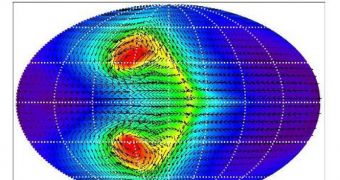About a month ago, an astronomy team shocked the international scientific community with evidence of the first Earth-like planet orbiting another star inside the habitable zone. Now, that exoplanet's atmosphere is modeled in a new study.
A few days after the discovery of the planet was announced, another research team cast doubts on its very existence, but evidence were not conclusive that Gliese 581g is not real.
As a result, the initial team that made the announcement is now stepping into the spotlight again, this time with a computer model of how the atmosphere of the exoplanet may look like.
Originally, the exoplanet was discovered by University of California in Santa Cruz (UCSC) astronomer Steve Vogt, who reported Gliese 581g to have three Earth masses, and a year spanning 36.6 Earth days.
Because the planet orbits a red dwarf, the habitable zone of the parent star is a lot closer to its surface than in our solar system. If Earth were this close to the Sun, it would experience temperatures such as those on Mercury, that would make life impossible.
In the new study, Vogt and his team show that the close proximity the exoplanet has to its parent star, Gliese 581, leads to a situation in which the “second Earth” is tidally-locked to the red dwarf.
This means that the gravitational pull of the star is so strong that it forces the planet to always keep the same face oriented towards it, similarly to how the Moon always shows the same face when viewed from Earth.
The astronomer therefore argues that the star-facing side of Gliese 581g is scorching desert, whereas the other side is covered in ice sheets, or is a frigid, Antarctic-like wasteland.
Regardless, it may be that the areas in between, where the temperature transition is made, benefit from lukewarm temperatures, in the range that would allow Earth-like life to develop.
Vogt also believes that taking global warming into account changes the situation for a bit. If the phenomenon is present on the planet, than it could be that both its sides are habitable. If not, the expert adds, at least one is.
But these were all suppositions that the expert made before the model. To get a better idea on things, he began working together with Swiss Federal Institute of Technology Zurich atmosphere-modeling expert Kevin Heng.
On a paper published in the top-rated journal Monthly Notices of the Royal Astronomical Society, the team shows that most comfortable area on the planet must be in a sideways V-shaped curve, as pictured.
“What we’re finding basically is that the patterns of warmth and cold on these things is a little more complicated. In fact, the most comfortable place is probably around the chevron, in the vortices,” Vogt argues. Addressing the controversy surrounding the very existence of the exoplanet, the expert says that the study is important in other ways than when directly applied to this particular cosmic body.
“Whether or not Gliese 581g is confirmed, there’s going to be others like this,” Wired quotes him as saying.
“‘What is life like there?’ is becoming an interesting field in its own right. We have enough computing power now to make some interesting conclusions about where things might live,” the astronomer concludes.

 14 DAY TRIAL //
14 DAY TRIAL //